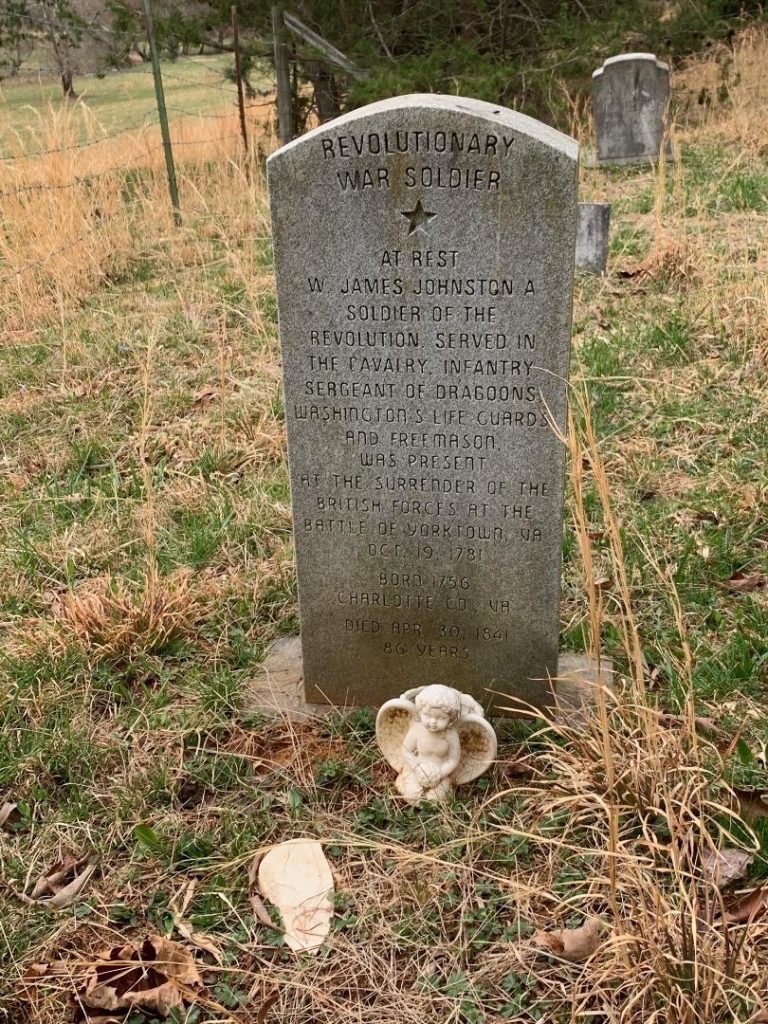
By Jarred Marlowe and Lori Amos Doss
I have often wondered what it would have been like to have been a part of the inner circle of the Founding Fathers as our nation declared and fought for independence. To have been there with George Washington as he led the Continental Army against the mighty British forces and to have spent time with him during the war would be the stuff of legend.
But unbeknownst to many, there was a man from Henry County who had the opportunity to be at Washington’s side and in his inner circle for a large part of the Revolutionary War.
James Johnston was born around the year 1756 in Caroline County, Virginia. In November 1776, he volunteered to join the Continental Army and a few months later, in May 1777, Johnston was chosen to be a part of the Commander-in-Chief’s guard, also known as the Life Guards.
This small detachment was a group of men hand-selected by their commanding officers to protect the life of George Washington, along with the Continental Army’s money supply and official documents that traveled along with Washington.
In the summer of 1777, Washington was stationed in New Jersey when a young man by the name of the Marquis de Lafayette joined Washington to offer his expertise and French support. Johnston would come to admire Lafayette, just as Washington did.
While the Life Guards were not required to engage in battle, many stepped up to help when the battle lines were stretched thin.
Johnston fought under the command of Lafayette at the Battle of Brandywine in September 1777. Lafayette was wounded during the battle, so Washington sent a small detachment of men that included Johnston to escort and stay with Lafayette in Bethlehem, Pennsylvania while he recovered from his injury. During Lafayette’s recovery time, the British captured Philadelphia. Lafayette, once healed, asked for a small group of men to go on reconnaissance missions to gather intelligence about British activity in Pennsylvania. We can conclude from later correspondence that Johnston was with Lafayette during this time.
The winter of 1777-1778 saw Johnston camped with Washington’s army during their infamous stay at Valley Forge, Pennsylvania. The conditions and life in the camp were beyond brutal, and many soldiers died from starvation and sickness during the winter season.
After a series of skirmishes in the spring of 1778, Johnston and 74 other members of the Life Guard joined Col. Daniel Morgan to pursue the British as they withdrew their forces towards New York City. According to Johnston, the fighting was heavy and often, his “cartridge box never left his neck.”
James Johnston served as a Life Guard until his 3-year volunteer enlistment ended in November 1779. He was discharged at West Point, New York, and immediately asked to re-enlist – this time for only two years and a new rank as a sergeant in the Virginia Line of Cavalry. (West Point would famously be surrendered to the British by Benedict Arnold less than a year later). His “signing bonus” included 80 British pounds, two months leave, and a promise of land.
Johnston served two years and took his promised furlough, but on the way home, he learned that the Continental Army under Nathanael Greene, was struggling against Lord Cornwallis in battles throughout North and South Carolina. Johnston rounded up a dozen former Continental Army soldiers and joined Greene’s efforts, including fighting in the famed Battle of Guilford Court House in March 1781. After the battle, Greene discharged Johnston and his men, and told them to return to their homes to enjoy their well-deserved rest.
While at home, Johnston learned that his old friend Lafayette was in Virginia being pursued by Benedict Arnold and later Lord Cornwallis. Johnston once again volunteered to serve under Lafayette and headed towards the eastern part of the state to join up with him. After several careless errors by the British army and excellent planning by the Continental Army, the British found themselves trapped in the city of Yorktown. Johnston was part of the Continental Army’s effort that put the town under siege. During one of the small skirmishes that led to eventual British surrender, Johnston was wounded and had his belongings stolen. Not wanting to risk dying in a hospital, Johnston had a friend dress the wound and fashion him a pair of crutches so he could leave and finally return home for good.
Johnston could leave and finally return home for good.
Johnston moved to Henry County and shortly after moving, he married Joice Wells in 1789. They established their homeplace in the present day Mountain Valley community in Axton under the shadow of Turkeycock Mountain. He and Joice would have six children. His farm remains in the Johnston family to this day.
(Jarred Marlowe is the Vice President of the Col. George Waller Chapter of the Sons of the American Revolution and currently serves on the board of directors for the Martinsville-Henry County Historical Society. He is a descendent of James Johnston. Lori Amos Doss is a James Johnston descendent from Callands, VA.)




